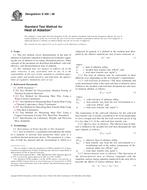Potřebujeme váš souhlas k využití jednotlivých dat, aby se vám mimo jiné mohly ukazovat informace týkající se vašich zájmů. Souhlas udělíte kliknutím na tlačítko „OK“.
ASTM E458-08
Standard Test Method for Heat of Ablation
Automaticky přeložený název:
Standardní zkušební metoda pro Heat ablace
NORMA vydána dne 1.5.2008
Informace o normě:
Označení normy: ASTM E458-08
Poznámka: NEPLATNÁ
Datum vydání normy: 1.5.2008
Kód zboží: NS-46869
Počet stran: 7
Přibližná hmotnost: 21 g (0.05 liber)
Země: Americká technická norma
Kategorie: Technické normy ASTM
Anotace textu normy ASTM E458-08 :
Keywords:
ablation, cold-wall heat of ablation, effective heat of ablation, heat of ablation, thermochemical heat of ablation, Ablative materials, Heating tests--aerospace materials, Mass, ICS Number Code 17.200.10 (Heat. Calorimetry)
Doplňující informace
| Significance and Use | ||||||||||||||||||
|
General—The heat of ablation provides a measure of the ability of a material to serve as a heat protection element in a severe thermal environment. The parameter is a function of both the material and the environment to which it is subjected. It is therefore required that laboratory measurements of heat of ablation simulate the service environment as closely as possible. Some of the parameters affecting the heat of ablation are pressure, gas composition, heat transfer rate, mode of heat transfer, and gas enthalpy. As laboratory duplication of all parameters is usually difficult, the user of the data should consider the differences between the service and the test environments. Screening tests of various materials under simulated use conditions may be quite valuable even if all the service environmental parameters are not available. These tests are useful in material selection studies, materials development work, and many other areas. Steady-State Conditions—The nature of the definition of heat of ablation requires steady-state conditions. Variances from steady-state may be required in certain circumstances; however, it must be realized that transient phenomena make the values obtained functions of the test duration and therefore make material comparisons difficult. Temperature Requirements—In a steady-state
condition, the temperature propagation into the material will move
at the same velocity as the gas-ablation surface interface. A
constant distance is maintained between the ablation surface and
the isotherm representing the temperature front. Under steady-state
ablation the mass loss and length change are linearly related.
Exposure Time Requirements—The exposure time required to achieve steady-state may be determined experimentally by the use of multiple models by plotting the total mass loss as a function of the exposure time. The point at which the curve departs significantly from linearity is the minimum exposure time required for steady-state ablation to be established. Cases exist, however, in the area of very high heating rates and high shear where this type of test for steady-state may not be possible. |
||||||||||||||||||
| 1. Scope | ||||||||||||||||||
|
1.1 This test method covers determination of the heat of ablation of materials subjected to thermal environments requiring the use of ablation as an energy dissipation process. Three concepts of the parameter are described and defined: cold wall, effective, and thermochemical heat of ablation. 1.2 This standard does not purport to address all of the safety concerns, if any, associated with its use. It is the responsibility of the user of this standard to establish appropriate safety and health practices and determine the applicability of regulatory limitations prior to use. |
||||||||||||||||||
| 2. Referenced Documents | ||||||||||||||||||
|
||||||||||||||||||
Odebírejte informace o nově vydaných normách ZDARMA:
Chcete pravidelně odebírat informace o nově vycházejících normách z celého světa a to zcela zdarma?
Přihlašte se k odběru. Vše je velice jednoduché a absolutně ZDARMA.
Na výběr máte vydavatele z celého světa.




 Cookies
Cookies
